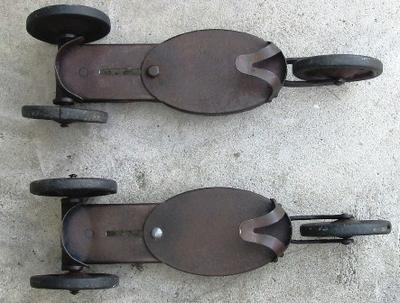Roller skates
Production date
Circa 1900
See full details
Object detail
Accession number
1996.6
Production period
Description
1 pair roller skates - 3 wheels, 1 front and 2 at the back extending. Hard dished rubber wheels. One smaller wheel in the front and 2 slightly larger wheels at the back. The dished wheels have a hard rubber surface. The metal wheels have been riveted (4 rivets) onto a frame. There is a dark metal footpad with a metal toe clip to clamp over the shoe. There is an adjustment slot for altering the foot size as required. There is a metal heel pad with a heel clip. The heel clip is located between the 2 rear wheels.
Brief History
The first known pair of roller skates was made in the 1760s and worn by their maker, an English instrument maker and inventor, Joseph Merlin, to a masquerade party. The wheels were in a single line down the middle of the boot, akin to modern roller blades or inline skates.
In 1863, an American, James Plimpton, made and patented skates with 2 pairs of wheels, one under the ball of the foot and the other pair under the heel. Instead of being attached directly to the sole of the skate, the wheel assembly was fastened to a pivot and had a rubber cushion, which allowed the skater to curve by shifting his weight. Plimpton's design was the first dry-land skate that could manoeuvre a smooth curve and allow the skater to skate backwards. This greater manoeuvrability saw the four-wheeled roller skate come to dominate the market and Plimpton skates are still used today.
In 1863, an American, James Plimpton, made and patented skates with 2 pairs of wheels, one under the ball of the foot and the other pair under the heel. Instead of being attached directly to the sole of the skate, the wheel assembly was fastened to a pivot and had a rubber cushion, which allowed the skater to curve by shifting his weight. Plimpton's design was the first dry-land skate that could manoeuvre a smooth curve and allow the skater to skate backwards. This greater manoeuvrability saw the four-wheeled roller skate come to dominate the market and Plimpton skates are still used today.
Marks
AJAX / M Embossed
Media/Materials
Credit Line
Circa 1900. Roller skates, 1996.6. The Museum of Transport and Technology (MOTAT).


Public comments
Be the first to comment on this object record.